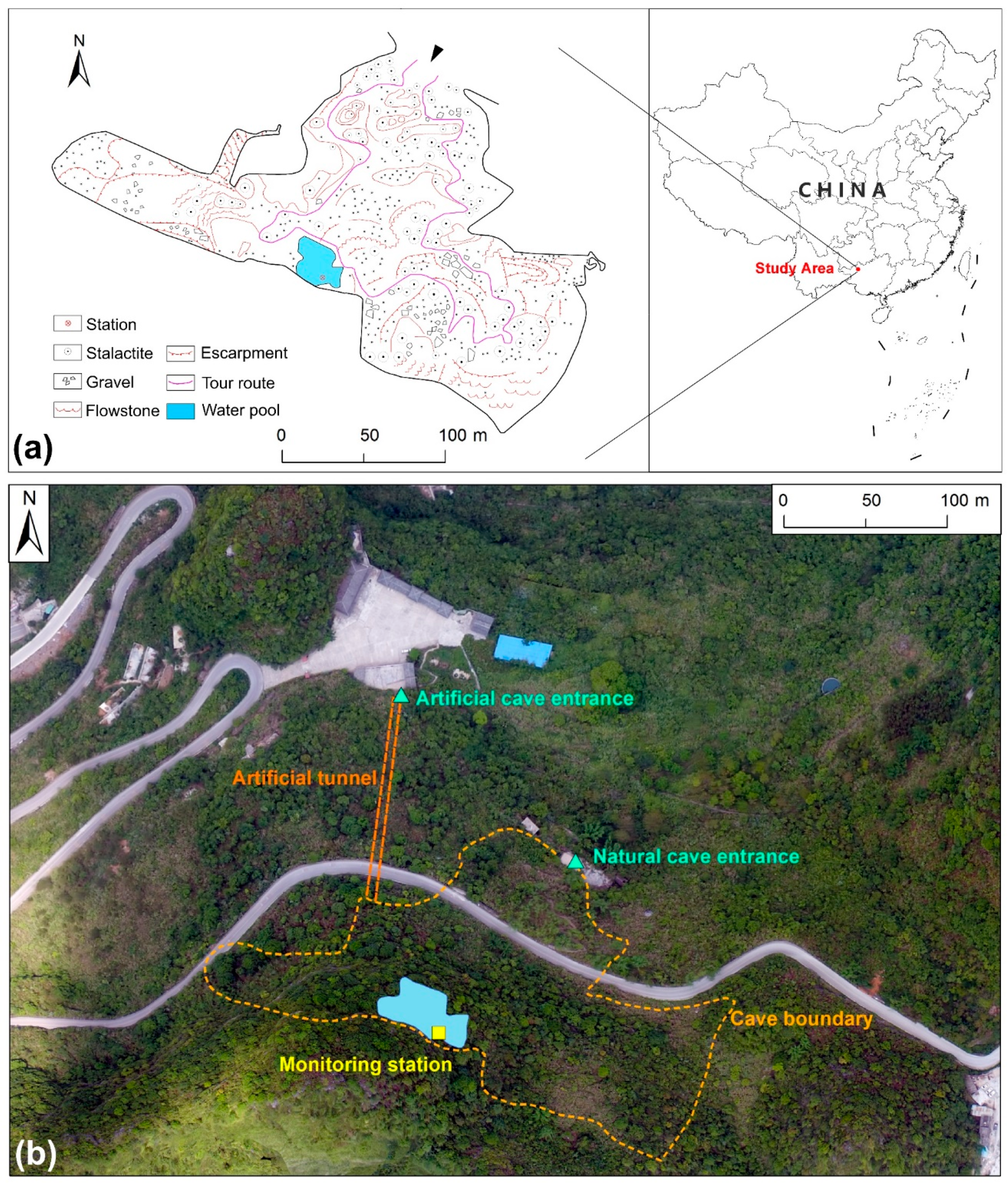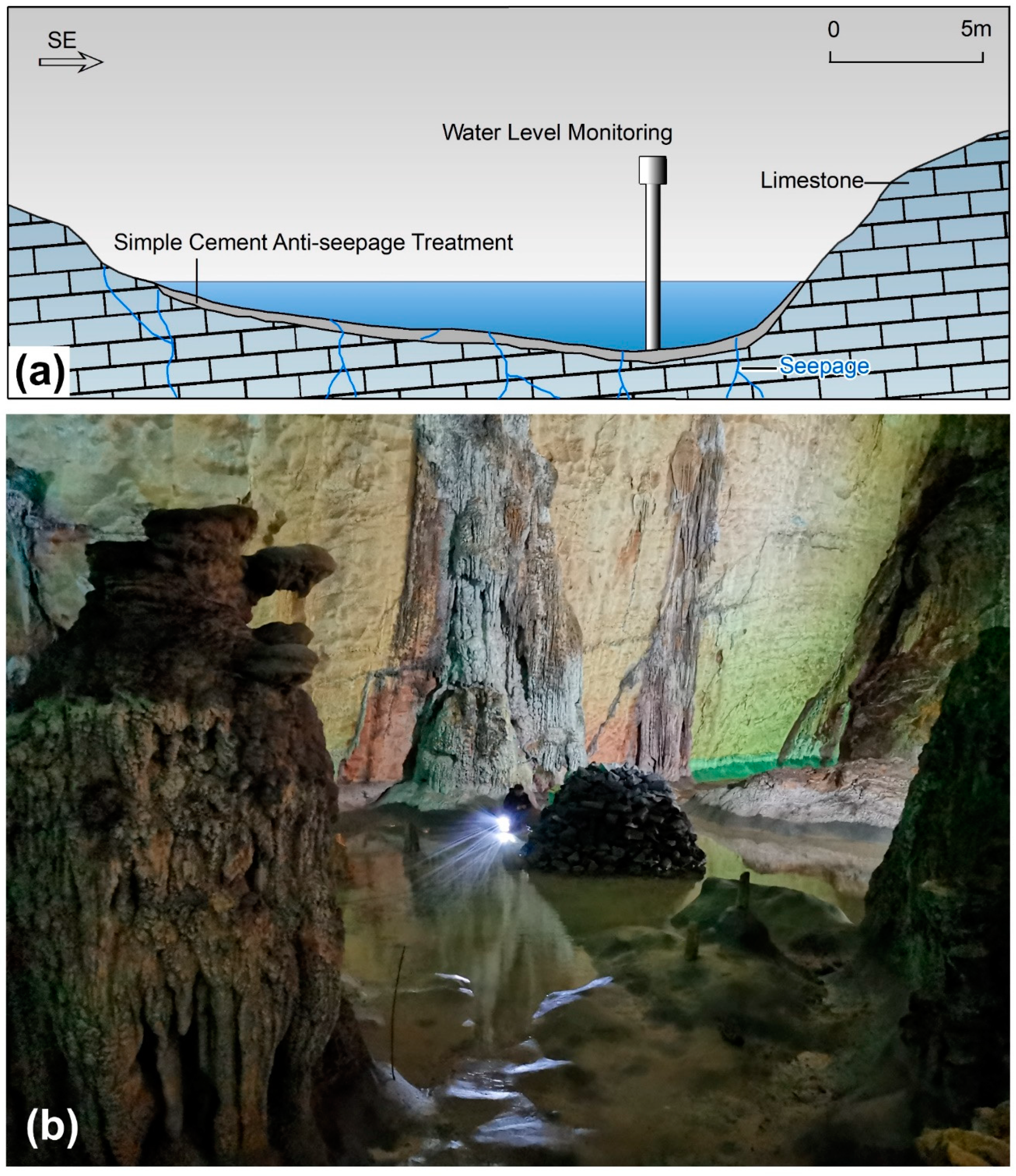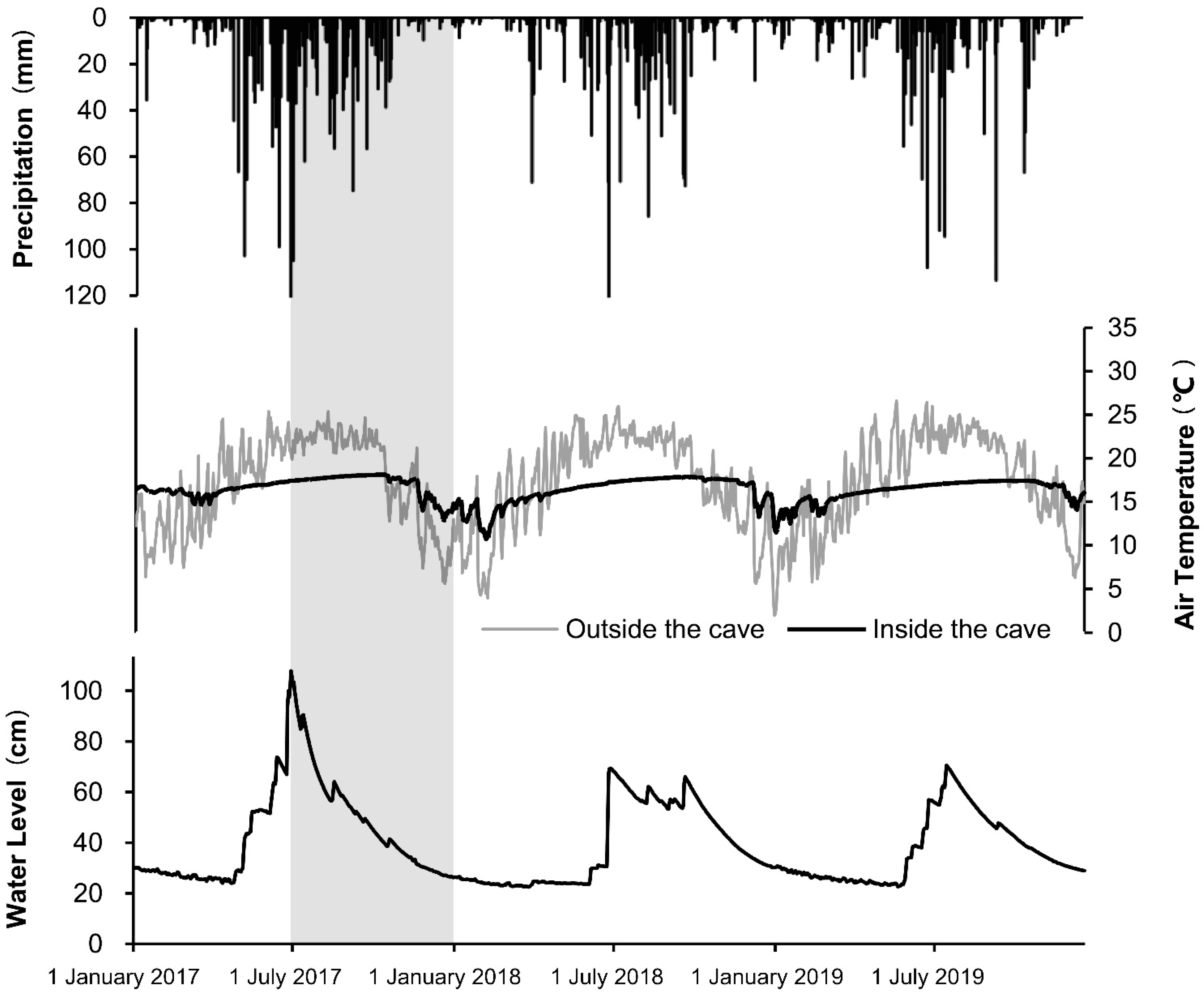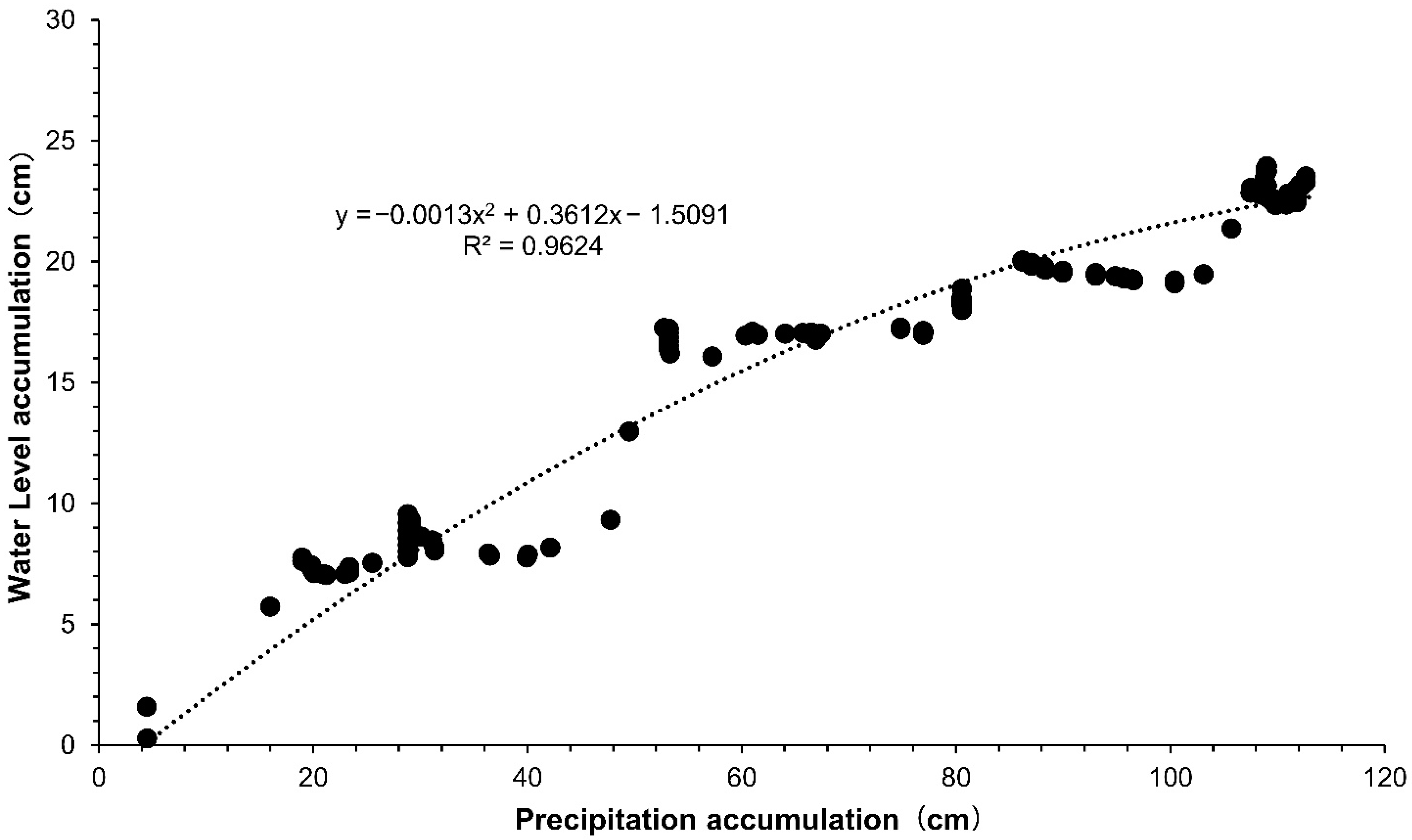The Recharge Process and Influencing Meteorological Parameters Indicated by Cave Pool Hydrology in the Bare Karst Mountainous Area
Abstract
1. Introduction
2. Materials and Methods
2.1. Description of Study Area
2.2. Methodology
3. Results and Discussion
3.1. Monitoring Results of the Cave Pool
3.2. Runoff Analysis in Cave Vadose Zone Based on Recession Analysis
3.3. Recession Model Validation
3.4. Multiple Linear Regression
4. Conclusions
Author Contributions
Funding
Institutional Review Board Statement
Informed Consent Statement
Data Availability Statement
Conflicts of Interest
References
- Goldscheider, N.; Chen, Z.; Auler, A.S.; Bakalowicz, M.; Broda, S.; Drew, D.; Hartmann, J.; Jiang, G.; Moosdorf, N.; Stevanovic, Z.; et al. Global distribution of carbonate rocks and karst water resources. Hydrogeol. J. 2020, 28, 1661–1677. [Google Scholar] [CrossRef]
- Aquilina, L.; Ladouche, B.; Dörfliger, N. Water storage and transfer in the epikarst of karstic systems during high flow periods. J. Hydrol. 2006, 327, 472–485. [Google Scholar] [CrossRef]
- Bakalowicz, M. Karst groundwater: A challenge for new resources. Hydrogeol. J. 2005, 13, 148–160. [Google Scholar] [CrossRef]
- Chen, H.S.; Yang, J.; Fu, W.; He, F.; Wang, K.L. Characteristics of slope runoff and sediment yield on karst hill-slope with different land-use types in northwest guangxi. Trans. Chin. Soc. Agric. Eng. 2012, 28, 121–126. (In Chinese) [Google Scholar]
- Zhu, X.F.; Chen, H.S.; Fu, Z.Y.; Wang, K.L.; Zhang, W.; Xu, Q.X.; Fang, R.J. Runoff and nitrogen loss characteristics in soil-epikarst system on a karst shrub hillslope. Chin. J. Appl. Ecol. 2017, 28, 2197–2206. (In Chinese) [Google Scholar]
- Fu, Z.Y.; Chen, H.S.; Zhang, W.; Xu, Q.X.; Wang, S.; Wang, K.L. Subsurface flow in a soil-mantled subtropical dolomite karst slope: A field rainfall simulation study. Geomorphology 2015, 250, 1–14. [Google Scholar] [CrossRef]
- Jiang, G.; Guo, F.; Lo, K.F.A.; Liu, F.; Guo, Y.; Wu, W.; Polk, J.S. Utilization status of rainwater harvesting and its improvement techniques in bare karst areas for domestic use and ecological restoration. Carbonates Evaporites 2019, 34, 1381–1390. [Google Scholar] [CrossRef]
- Wang, S.; Fu, Z.; Chen, H.; Nie, Y.; Xu, Q. Mechanisms of surface and subsurface runoff generation in subtropical soil-epikarst systems: Implications of rainfall simulation experiments on karst slope. J. Hydrol. 2020, 580, 124370. [Google Scholar] [CrossRef]
- Gunn, J. Point-recharge of limestone aquifers—A model from New Zealand karst. J. Hydrol. 1983, 61, 19–29. [Google Scholar] [CrossRef]
- Fiorillo, F.; Doglioni, A. The relation between karst spring discharge and rainfall by cross-correlation analysis (Campania, southern Italy). Hydrogeol. J. 2010, 18, 1881–1895. [Google Scholar] [CrossRef]
- Fiorillo, F.; Pagnozzi, M.; Ventafridda, G. A model to simulate recharge processes of karst massifs. Hydrol. Process. 2015, 29, 2301–2314. [Google Scholar] [CrossRef]
- Kovačič, G.; Ravbar, N. Characterisation of selected karst springs in Slovenia by means of a time series analysis. In Karst without Boundaries; Stevanović, Z., Krešič, N., Kukurić, N., Eds.; CRC Press: Boca Raton, FL, USA, 2016. [Google Scholar]
- Williams, P.W. The role of the subcutaneous zone in karst hydrology. J. Hydrol. 1983, 61, 45–67. [Google Scholar] [CrossRef]
- Guo, X.; Jiang, G.; Gong, X.; Yin, J.; Wu, X. Recharge processes on typical karst slopes implied by isotopic and hydrochemical indexes in Xiaoyan Cave, Guilin, China. J. Hydrol. 2015, 530, 612–622. [Google Scholar] [CrossRef]
- Arbel, Y.; Greenbaum, N.; Lange, J.; Inbar, M. Infiltration processes and flow rates in developed karst vadose zone using tracers in cave drips. Earth. Surf. Proc. Land. 2010, 35, 1682–1693. [Google Scholar] [CrossRef]
- Sheffer, N.A.; Cohen, M.; Morin, E.; Grodek, T.; Gimburg, A.; Magal, E.; Gvirtzman, H.; Nied, M.; Isele, D.; Frumkin, A. Integrated cave drip monitoring for epikarst recharge estimation in a dry Mediterranean area, Sif Cave, Israel. Hydrol. Process. 2011, 25, 2837–2845. [Google Scholar] [CrossRef]
- Ayalon, A.; Bar-Matthews, M.; Sass, E. Rainfall-recharge relationships within a karstic terrain in the Eastern Mediterranean semi-arid region, Israel: δ 18O and δD characteristics. J. Hydrol. 1998, 207, 18–31. [Google Scholar] [CrossRef]
- Baker, A.; Brunsdon, C. Non-linearities in drip water hydrology: An example from Stump Cross Caverns, Yorkshire. J. Hydrol. 2003, 277, 151–163. [Google Scholar] [CrossRef]
- Gregory, L.; Wilcox, B.P.; Shade, B.; Munster, C.; Owens, K.; Veni, G. Large-scale rainfall simulation over shallow caves on karst shrublands. Ecohydrology 2009, 2, 72–80. [Google Scholar] [CrossRef]
- Kurniawan, I.A.; Adji, T.N.; Nurkholis, A.; Haryono, E.; Fatoni, H.; Waskito, W.A.; Cahyadi, A.; Agniy, R.F. Karst aquifer response by time series analysis applications in Jonggrangan Karst, Java Island, Indonesia. Environ. Earth Sci. 2019, 78, 379. [Google Scholar] [CrossRef]
- Lorenz, D.L.; Delin, G.N. A regression model to estimate regional ground water recharge. Ground Water 2007, 45, 196–208. [Google Scholar] [CrossRef]
- Kogovšek, J.; Petrič, M. Solute transport processes in a karst vadose zone characterized by long-term tracer tests (the cave system of Postojnska Jama, Slovenia). J. Hydrol. 2014, 519, 1205–1213. [Google Scholar] [CrossRef]
- Petrič, M.; Kogovšek, J.; Ravbar, N. Effects of the vadose zone on groundwater flow and solute transport characteristics in mountainous karst aquifers—The case of the Javorniki–Snežnik massif (SW Slovenia). Acta Carsologica 2018, 47. [Google Scholar] [CrossRef]
- Jean, B.; Bruce, B.; Marc, F. Spelunca Memories N°37: Voyages en Terre Chinoise Tome 4—Inventaire Speleologique du District de Fengshan; Fédération Française de Spéléologie: Lyon, Franch, 2018; pp. 28–29. (In French) [Google Scholar]
- Liu, F.; Jiang, G.; Wu, W.; Guo, F.; Guo, Y. Discussion on Hydrogeological Genesis of Yuanyang Spring in Fengshan County, Guangxi. Guangxi Sci. 2017, 24, 623–628. (In Chinese) [Google Scholar]
- Fiorillo, F. Tank-reservoir drainage as a simulation of the recession limb of karst spring hydrographs. Hydrogeol. J. 2011, 19, 1009–1019. [Google Scholar] [CrossRef]
- Yuan, X. Four-Water Conversion Model and Estimation of Runoff Generation in Banzhai Underground River Watershed; China University of Geosciences: Beijing, China, 2018. (In Chinese) [Google Scholar]








| Indicators | Content |
|---|---|
| pH | 8.21 |
| DO | 7.52 mg/L |
| EC | 145.5 μS/cm |
| Ca2+ | 39.46 mg/L |
| K+ | 0.64 mg/L |
| Na+ | 0.32 mg/L |
| Mg2+ | 0.35 mg/L |
| NH4+ | 0.06 mg/L |
| HCO3− | 112.55 mg/L |
| NO3− | 1.85 mg/L |
| PO43− | 0.02 mg/L |
| Cl− | 0.40 mg/L |
| SO42− | 9.64 mg/L |
| SiO2 | 4.12 mg/L |
| No. | Recharge Events | ΔHrecharge (cm) | Sum of Rainfall 1–3 Days Ago (R3) (cm) | Sum of Rainfall 4–7 Days Ago (R4) (cm) | Sum of Evaporation 7 Days Ago (E7) (cm) |
|---|---|---|---|---|---|
| 1 | 2017 July 12 | 2.027 | 7.44 | 2.77 | 1.51 |
| 2 | 2017 July 22 | 0.108 | 2.39 | 1.17 | 2.07 |
| 3 | 2017 July 31 | 0.365 | 0.00 | 5.44 | 2.94 |
| 4 | 2017 August 16 | 4.280 | 9.46 | 8.69 | 1.46 |
| 5 | 2017 August 26 | 0.166 | 7.13 | 0.00 | 2.22 |
| 6 | 2017 September 4 | 0.254 | 0.46 | 5.41 | 1.93 |
| 7 | 2017 October 17 | 1.895 | 2.72 | 4.75 | 1.92 |
| 8 | 2017 November 11 | 0.422 | 0.18 | 0.36 | 1.39 |
| 9 | 2017 November 26 | 0.192 | 1.07 | 0.24 | 1.62 |
| 10 | 2017 December 21 | 0.211 | 0.00 | 0.33 | 1.45 |
| 11 | 2017 December 31 | 0.237 | 0.61 | 0.25 | 1.02 |
| Coefficients | Standard error | Significance | |
|---|---|---|---|
| Intercept | 1.270 | 0.542 | 0.052 |
| R3 | 0.178 | 0.046 | 0.006 |
| R4 | 0.293 | 0.056 | 0.001 |
| E7 | −0.924 | 0.296 | 0.017 |
Publisher’s Note: MDPI stays neutral with regard to jurisdictional claims in published maps and institutional affiliations. |
© 2021 by the authors. Licensee MDPI, Basel, Switzerland. This article is an open access article distributed under the terms and conditions of the Creative Commons Attribution (CC BY) license (http://creativecommons.org/licenses/by/4.0/).
Share and Cite
Liu, F.; Jiang, G.; Wang, J.; Guo, F. The Recharge Process and Influencing Meteorological Parameters Indicated by Cave Pool Hydrology in the Bare Karst Mountainous Area. Sustainability 2021, 13, 1766. https://doi.org/10.3390/su13041766
Liu F, Jiang G, Wang J, Guo F. The Recharge Process and Influencing Meteorological Parameters Indicated by Cave Pool Hydrology in the Bare Karst Mountainous Area. Sustainability. 2021; 13(4):1766. https://doi.org/10.3390/su13041766
Chicago/Turabian StyleLiu, Fan, Guanghui Jiang, Jia Wang, and Fang Guo. 2021. "The Recharge Process and Influencing Meteorological Parameters Indicated by Cave Pool Hydrology in the Bare Karst Mountainous Area" Sustainability 13, no. 4: 1766. https://doi.org/10.3390/su13041766
APA StyleLiu, F., Jiang, G., Wang, J., & Guo, F. (2021). The Recharge Process and Influencing Meteorological Parameters Indicated by Cave Pool Hydrology in the Bare Karst Mountainous Area. Sustainability, 13(4), 1766. https://doi.org/10.3390/su13041766






